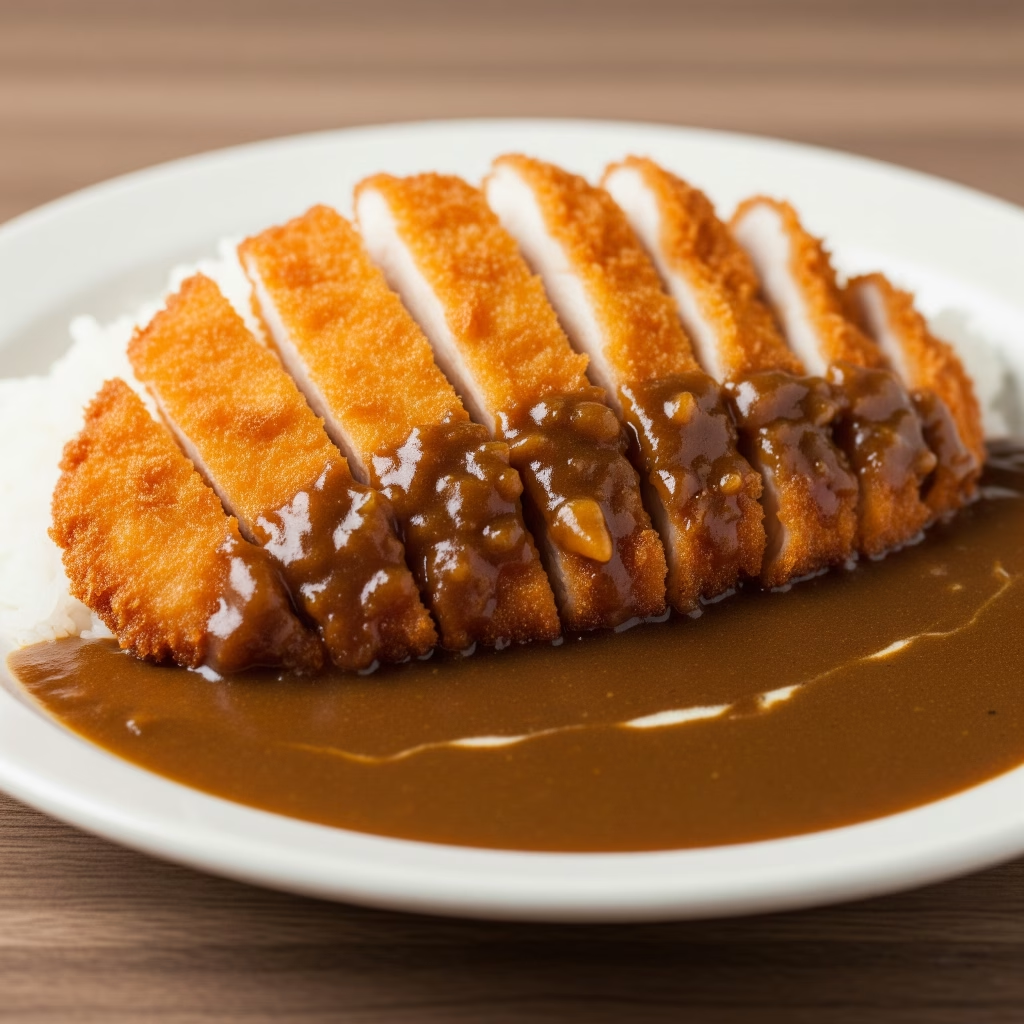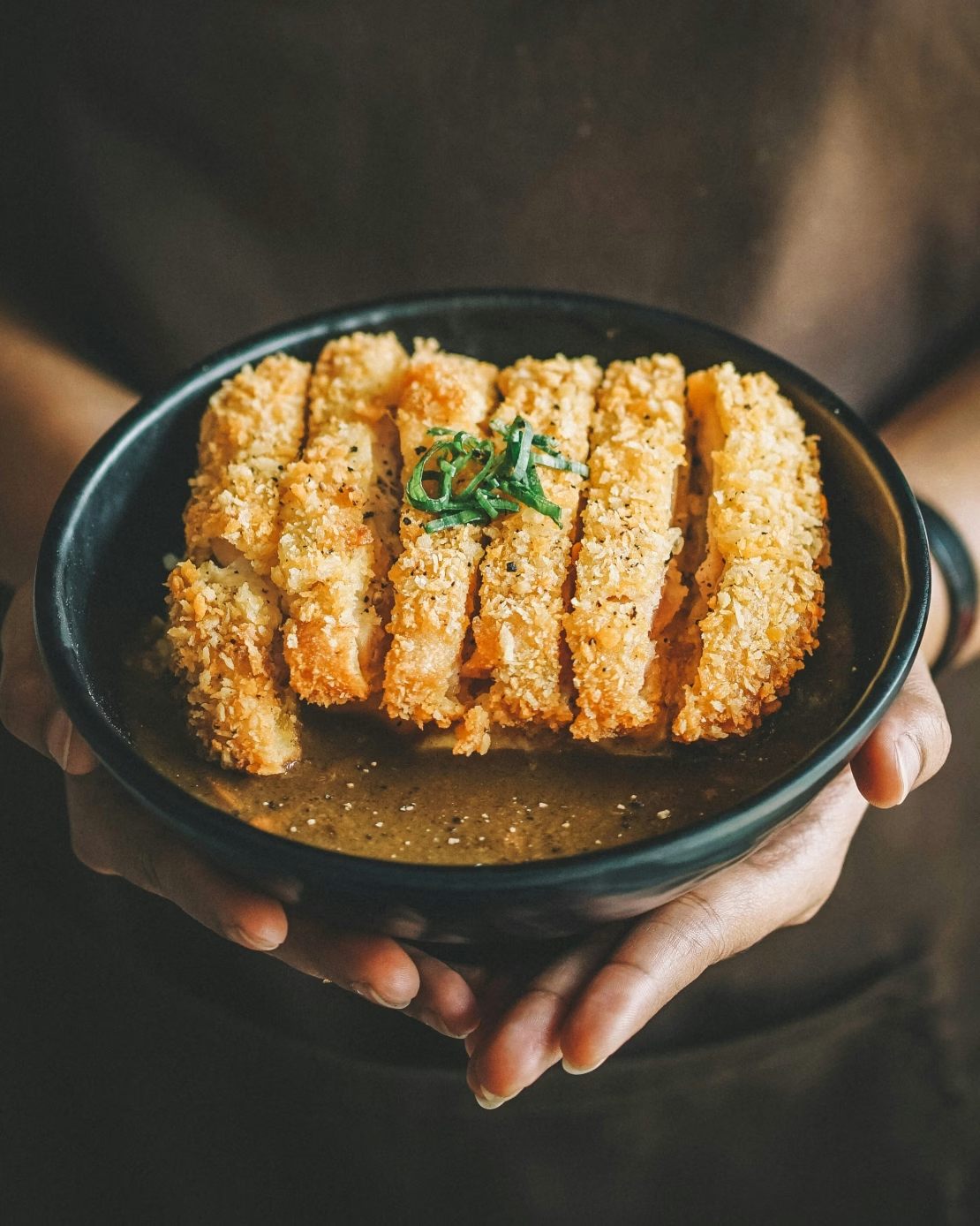Japanese Curry with Chicken Cutlet (Katsu Curry) is the ultimate comfort food from Japan—a flavorful fusion of hearty curry, crispy golden chicken cutlet, and warm steamed rice.
Unlike spicier South Asian curries, Japanese curry is mild, rich, slightly sweet, and incredibly satisfying. The dish brings together three core elements: a velvety roux-based curry loaded with vegetables, a perfectly breaded and fried chicken breast (called chicken katsu), and fluffy rice that soaks up all the delicious sauce.
Whether you’re new to Japanese cuisine or a long-time fan, this beloved dish is sure to impress with its layered textures and soul-warming flavor.
Table of Contents
Ingredients
For the Chicken Katsu:
- 2 boneless, skinless chicken breasts (flattened to even thickness)
- 1 tsp salt
- ½ tsp black pepper
- ½ cup all-purpose flour
- 2 large eggs, beaten
- 1 cup panko breadcrumbs (Japanese breadcrumbs)
- Oil for frying (vegetable or canola)
For the Japanese Curry:
- 1 large onion, finely sliced
- 2 cloves garlic, minced
- 1-inch piece ginger, grated
- 1 large carrot, peeled and diced
- 1 medium potato, peeled and cubed
- 2 cups chicken stock or water
- 1 apple (Fuji preferred), grated
- 1 tbsp tomato paste or ketchup
- 1 tbsp soy sauce
- 1 tbsp Worcestershire sauce
- 1 tbsp curry powder (Japanese style)
- 2 tbsp all-purpose flour
- 2 tbsp butter
For Serving:
- 2 cups cooked Japanese short-grain rice
- Pickled red radish or ginger (optional garnish)
- Chopped parsley (optional)
Serves
Serves: 2–3 people
Prep Time: 20 minutes
Cooking Time: 40 minutes
Total Time: 1 hour
Step-by-Step Instructions
Step 1: Prepare the Chicken Katsu
- Pound the Chicken: Flatten chicken breasts to about ½ inch thickness using a rolling pin or meat mallet. Season both sides with salt and pepper.
- Breading Setup: Set up three bowls: one with flour, one with beaten eggs, and one with panko breadcrumbs.
- Bread the Chicken: Dredge chicken in flour (shake off excess), then dip in egg, and finally coat with panko. Press lightly to ensure full coverage.
Step 2: Fry the Chicken
- Heat 1 inch of oil in a skillet to 170°C (340°F).
- Fry chicken for 4–5 minutes per side or until golden brown and cooked through.
- Drain on paper towels. Let rest for a few minutes before slicing into strips.
Step 3: Make the Japanese Curry Sauce
- In a pot or large saucepan, melt butter and sauté onions over medium heat for 8–10 minutes until soft and golden.
- Add garlic and ginger; sauté for another minute.
- Stir in the flour and curry powder. Cook for 2 minutes to form a roux.
- Slowly add chicken stock while stirring to avoid lumps.
- Add carrots, potatoes, grated apple, soy sauce, tomato paste, and Worcestershire sauce.
- Simmer uncovered for 20–25 minutes or until vegetables are tender and sauce thickens. Stir occasionally.
Step 4: Assemble the Dish
- Spoon hot steamed rice onto a plate or shallow bowl.
- Ladle curry sauce next to the rice.
- Place sliced chicken katsu on top or alongside.
- Garnish with pickled radish, red ginger, or parsley.

Serving Suggestions
- Traditional: Serve with Japanese rice and pickled radish (fukujinzuke).
- With Udon Noodles: Replace rice with boiled udon for a fun twist.
- Bento-Style: Pack chicken katsu separately and pour curry when ready to eat.
- With a Fried Egg: Top with a sunny-side-up egg for added richness.
- Kids’ Version: Use mild curry mix and shape rice with fun molds.
Tips for Perfect Katsu Curry
- Use Japanese Panko: It gives a lighter, crispier crust than regular breadcrumbs.
- Grate an Apple: This adds natural sweetness and authentic Japanese flavor.
- Double Fry for Crispiness: Fry once to cook, then again for extra crunch if desired.
- Simmer Slowly: Let the curry gently reduce to develop deep flavor.
- Use a Flat Pan for Frying: Ensures even browning of the katsu.
Healthier Alternatives
- Air Fry the Chicken: Use an air fryer at 200°C (400°F) for 15 minutes with a light oil spray.
- Bake the Katsu: Bake at 220°C (425°F) for 20–25 minutes until crispy.
- Use Chicken Thighs: Offers more flavor and better fat content balance.
- Brown Rice or Quinoa: For a fiber-rich option instead of white rice.
- Vegetarian Curry: Replace chicken with tofu or eggplant and make the curry with vegetable stock.
Creative Variations
- Pork Katsu Curry: Use pork loin cutlets instead of chicken.
- Cheesy Katsu Curry: Add a slice of cheese inside the katsu before frying for molten goodness.
- Seafood Curry: Use fried shrimp cutlets and pour the same curry sauce.
- Spicy Curry: Add chili powder or sliced fresh chili to the curry sauce.
- Curry Sandwich: Serve leftover chicken and curry between two slices of bread.

Common Mistakes to Avoid
- Skipping the Roux Step: The roux is what thickens and flavors the curry—don’t rush it.
- Overcrowding the Pan While Frying: Results in soggy, unevenly cooked chicken.
- Using Regular Breadcrumbs: They won’t give the desired crispy crust.
- Undercooking the Vegetables: Ensure potatoes and carrots are fully tender.
- Serving Immediately After Frying Without Resting: The juices will run—rest before slicing.
History of Japanese Curry with Chicken Cutlet (Katsu Curry)
1. Curry’s Journey from India to Japan
Japanese curry traces its roots back to the late 19th century when the British Royal Navy introduced curry powder to Japan during the Meiji Restoration. As Japan opened up to Western influence, British-style curry quickly found a home. Over time, the dish adapted to Japanese palates, becoming thicker, sweeter, and more stew-like than its South Asian counterpart.

2. The Rise of Katsu and Yoshoku Cuisine
The concept of deep-fried cutlets came from Western dishes like schnitzel. Japanese chefs embraced this in the early 20th century, creating tonkatsu (pork cutlet) and later chicken katsu. These Western-influenced dishes formed a culinary genre known as Yoshoku—Western food made the Japanese way.
3. The Marriage of Curry and Katsu
Katsu Curry became popular in Japanese eateries and homes around the 1960s. Combining two national favorites—crispy katsu and comforting curry—it quickly evolved into a beloved staple. School lunches, train station kiosks, and chain restaurants like CoCo Ichibanya helped cement its reputation as the ultimate Japanese comfort dish.
FAQs about Japanese Curry with Chicken Cutlet (Katsu Curry)
1. Is Japanese curry spicy?
No, it’s usually mild and slightly sweet, though you can make it spicy with chili.
2. What’s the difference between Indian curry and Japanese curry?
Indian curries are spice-heavy and aromatic, while Japanese curry is thick, mild, and roux-based.
3. Can I use store-bought curry roux cubes?
Yes, brands like Golden Curry or Vermont Curry are commonly used in Japan and offer great flavor.
4. Can I make curry ahead of time?
Absolutely. Curry tastes even better the next day as flavors deepen.
5. What is panko and why is it important?
Panko is Japanese breadcrumb—it gives the katsu its signature crispiness.
6. Can I freeze Katsu Curry?
Yes. Freeze curry separately from katsu to maintain crispiness.
7. What vegetables go best in Japanese curry?
Carrots, potatoes, onions, and occasionally peas or mushrooms.
8. Is this dish gluten-free?
Not by default, but you can use gluten-free flour, soy sauce, and breadcrumbs to adapt it.
9. Can I use beef or pork instead of chicken?
Yes! Pork katsu is very popular, and beef curry is another common version.
10. How do I reheat leftovers?
Reheat curry on the stove or microwave. Re-fry or toast the katsu for best texture.
Japanese Curry with Chicken Cutlet (Katsu Curry) is a delicious example of cultural fusion done right. It’s hearty, savory, slightly sweet, and offers the perfect contrast of textures—crispy fried chicken with a thick, velvety curry sauce. Whether you’re making it for a cozy dinner, a lunchbox treat, or to impress friends with your Japanese cooking skills, this dish never disappoints. Once you master the base, you can play with endless variations and make it a staple in your weekly meals. So grab your panko, pick your favorite curry powder, and dive into this unforgettable Japanese comfort dish.


